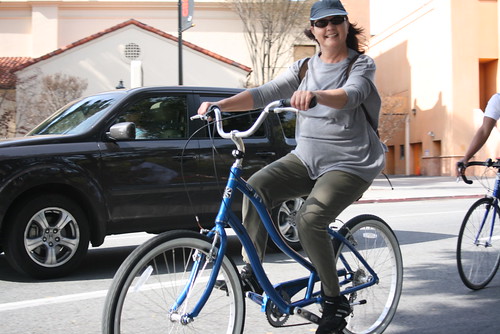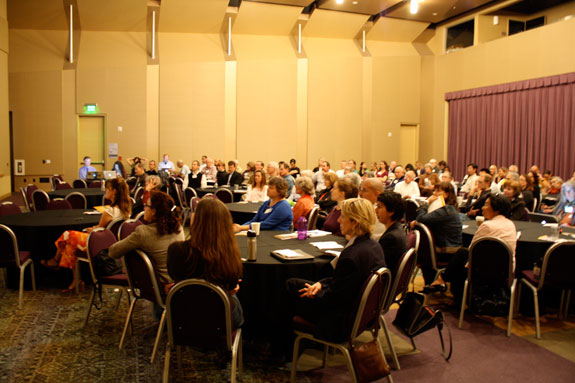Editor's note: This story marks the return of former Streetsblog San Francisco editor Bryan Goebel, who will be contributing occasional pieces.
Bicycle advocacy can be an especially daunting challenge in the South Bay and the Peninsula, where car-centric policies and culture rule the day. At this week's Silicon Valley Bike Advocacy Summit the focus was on improving relations between advocates and government officials at a time when a growing number of cities in the Silicon Valley and big companies such as Facebook, Google and Apple are starting to embrace the bicycle.
"We have more individuals who are becoming engaged and we have more institutions who are becoming engaged and more organizations who want to work with us," said Corinne Winter, executive director of the Silicon Valley Bike Coalition (SVBC). "There's a coalition of individuals and organizations who are really interested in seeing the bike become a commonplace thing, whether it be for transportation or recreation. That group of people is growing quickly in our area."
Although there are no official counts on the burgeoning numbers of people who ride bikes in Silicon Valley and the Peninsula, Winter said it's evident on the streets, especially in San Jose.
"Bike culture in San Jose has been growing really rapidly. It started with a lot of folks in the fixie crowd, and now I'm seeing more folks riding the Dutch-style bikes around town," said Winter. The popularity of the San Jose Bike Party has been another indication.
Just last week, the San Jose City Council unanimously approved six bike projects that will add 8 miles of new bike lanes downtown. Five of the projects will include road diets and lane reductions, and many sections will include bike lanes with extra space between motorists and bicyclists, said John Brazil, who heads up the city's bike/pedestrian program. The projects are expected to be completed by the end of June.
There was no opposition to the removal of vehicle lanes and that came as a surprise to the city's Transportation Director, Hans Larsen, who also attended this week's summit.
"I am blown away by that," Larsen told Streetsblog. "Ten years ago we were nearly crucified for talking about getting people out of their cars. You'd go to a community meeting talking about transit and bike use and you didn't get a whole lot of support."
But now "individual council members and the mayor particularly made points about reaffirming our direction to be a more sustainable city and get more people to bicycle." Larsen also credited SVBC for organizing and "getting the word out."
The city also plans on installing green bike lanes on San Fernando Street, along with a public bike share system at 15 stations in the downtown area, sometime this summer or fall. In addition, Brazil said plans are in the works to "test and identify best technologies for bike signal detection, including capabilities to accommodate green wave signal timing, bike lead interval signal timing, etc."
At the summit, veteran bicycle advocate Randy Neufeld gave an inspiring opening keynote, telling the crowd that advocates must go beyond engaging individuals, and create a true coalition that involves all segments of a city's political power structure.
"Think: how do you engage local employers? How do you engage local retail? How do you engage chambers of commerce and business associations? All community organizations, health organizations," said Neufeld, the director of the SRAM Cycling Fund. "I'm not suggesting you abandon your individual members. They're very important to you. But think about it. There's a difference between engaging a particular individual."
"Think of it not as a coalition addressing these people, or pushing these people, but getting the coalition to be something bigger than it is now, where these people are actually part of the coalition," he said. "We've got this difficult job of trying to change and move a culture and we're not pushing city hall, we're working with city hall to move the culture. They can themselves be a part of this coalition."
This year's 150-plus attendees included a number of mayors, elected officials, public health professionals and advocates interested in sharpening their skills. The SVBC relies heavily on volunteers to advocate for better bicycling infrastructure and smarter planning within the region's 40 jurisdictions.
Winter said one of the most significant outcomes of the summit was bringing together law enforcement officials and advocates for a closed-door session on how to deal with group bike rides "that have created animosity on both sides" in places like Woodside, Portola Valley and Los Altos Hills.
"There was a real sense of 'yes, this is something we want to work on, let's keep meeting about it.' We didn't come to any conclusions. It's a big topic and it's going to take awhile. But there was a commitment to enter into that process," said Winter.
Winter said SVBC's biggest priority is to work on adding and improving bike infrastructure.
"We've really tried to organize the coalition more and start local teams in three communities up and down the Peninsula. So, we have membership groups who meet in San Jose, Palo Alto and Redwood City on a monthly basis and we're leveraging our volunteers on the local level to find out exactly what is relevant on the infrastructure level," she said.






